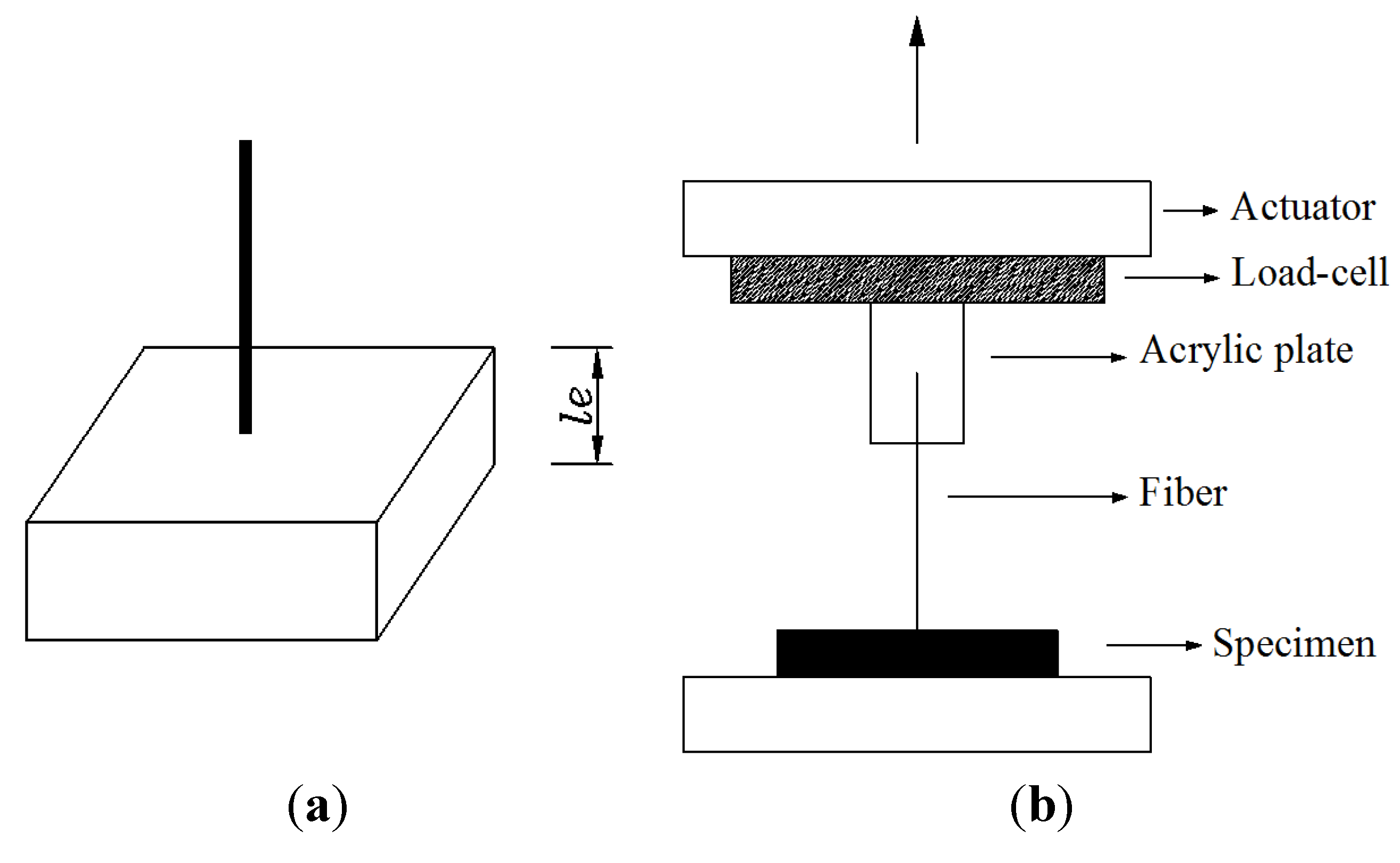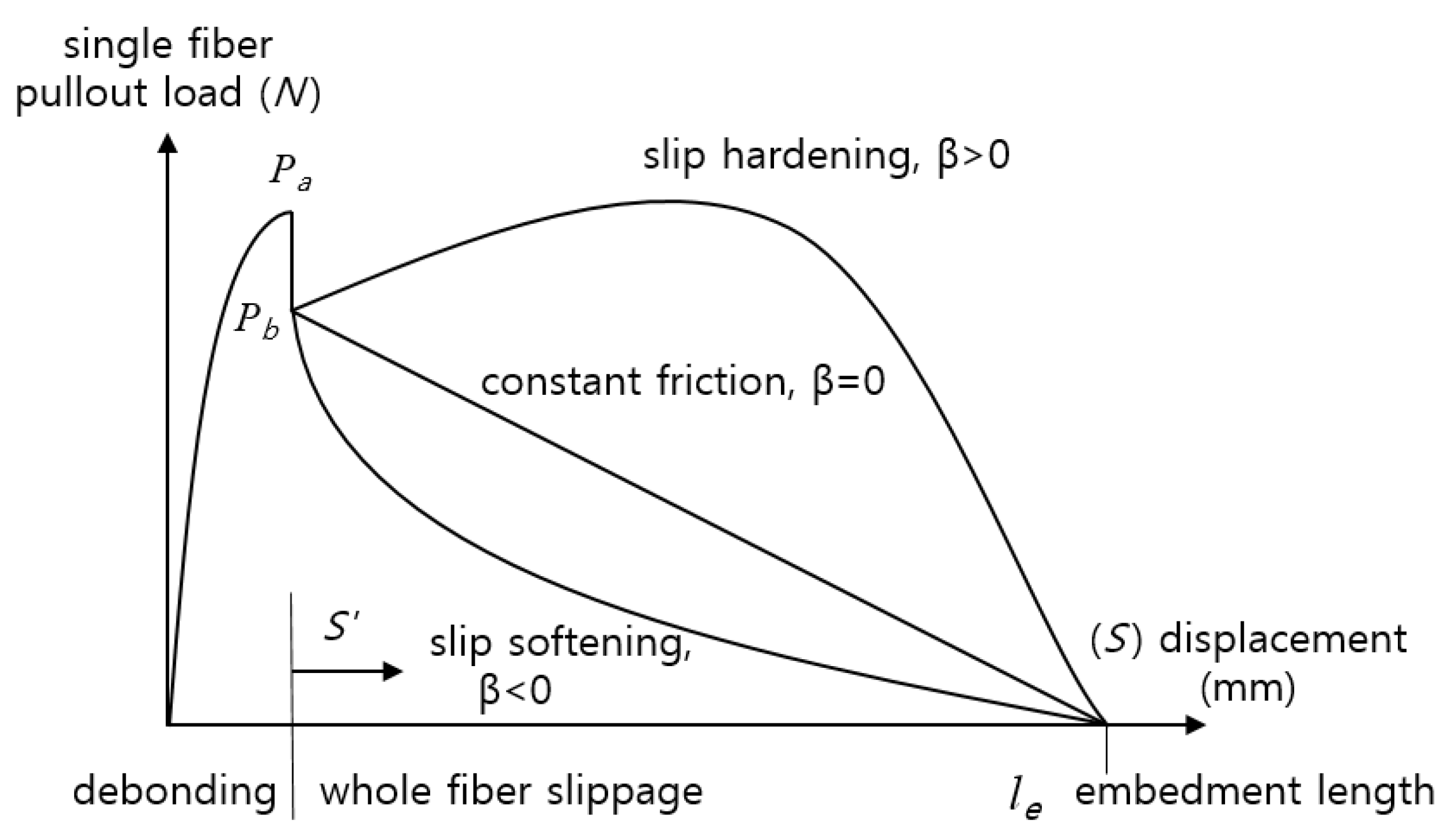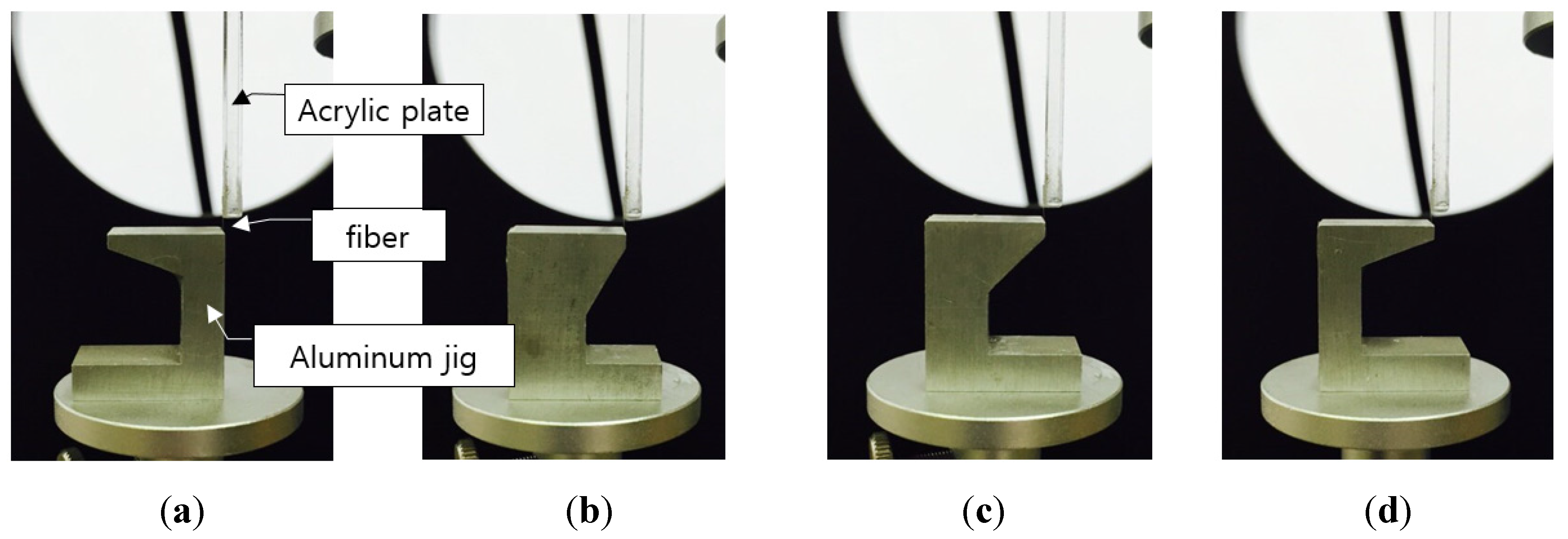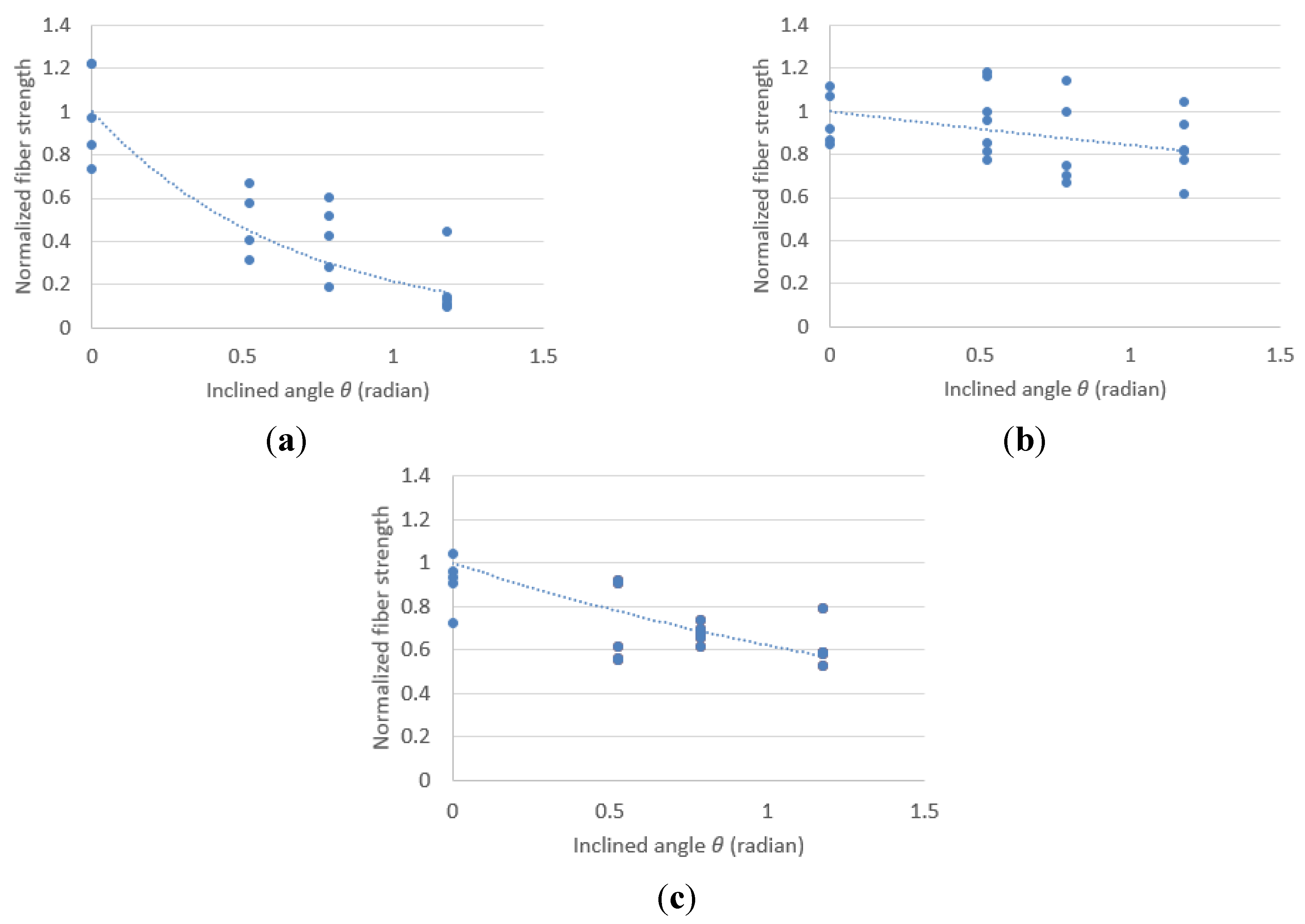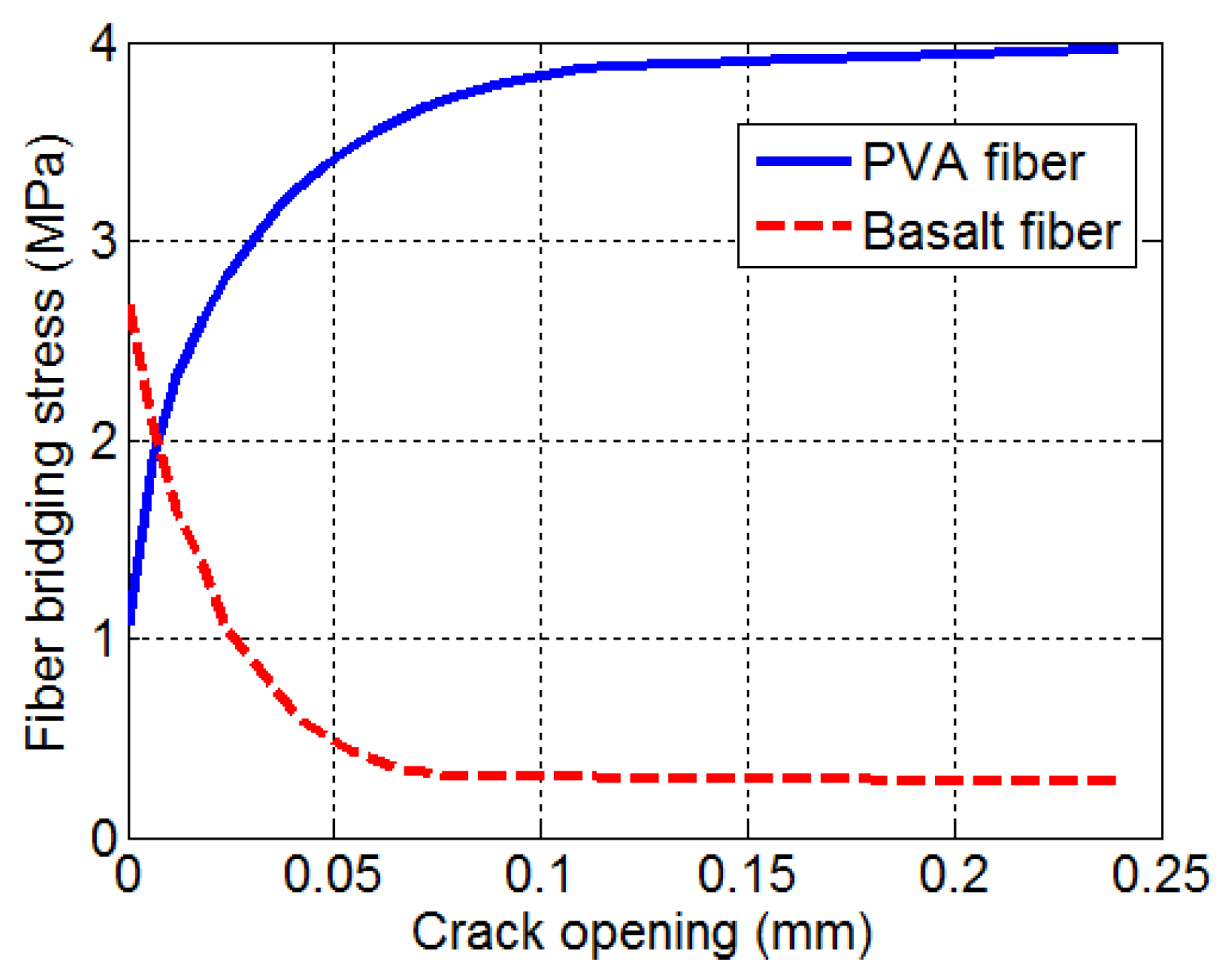1. Introduction
Experimental trials and patents involving the use of discontinuous steel reinforcing elements such as nails, wire segments, and metal chips to improve the properties of concrete have been ongoing since 1910 [
1]. During the early 1960s in the United States, the first major investigation was made to evaluate the potential of steel fibers as a reinforcement for concrete [
2]. Since then, a substantial amount of research, development, experimentation, and industrial application of steel or synthetic fiber reinforced concrete has occurred [
3].
In particular, engineered cementitious composites (ECC) have been developed to improve the toughness of quasi-brittle cement-based materials such as concrete and mortar. ECC is a micromechanically-designed cementitious composite that is able to exhibit extreme tensile strain capacity (typically more than 3%) while requiring only a moderate amount of fibers (typically less than 2% in volume fraction) [
4,
5,
6,
7]. Polyethylene (PE) or polyvinyl-alcohol (PVA) fibers with high aspect ratio over 300 and a high tensile strength over 1,000 MPa are generally used for ECC.
According to the Association Française de Génie Civil [
8], ultra-high performance concrete (UHPC) tends to have the following properties: a compressive strength that is greater than 150 MPa, internal fiber reinforcement that ensures non-brittle behavior, and a high binder content with special aggregates. Furthermore, UHPC tends to have a very low water content and can achieve sufficient rheological properties through a combination of optimized granular packing and the addition of high-range water reducing admixtures. Straight steel fiber of 0.2 mm in diameter is generally used for UHPC. The tensile strength of UHPC also ranges from 12.0 to 19.1 MPa while the tensile strain capacity ranges from 0.3% to 0.79 % in 28 days [
9,
10].
Table 1 lists the typical physical properties of steel and synthetic fibers in high-performance fiber-reinforced cementitious composites and UHPC, as well as in basalt fiber [
6,
10,
11,
12]. The steel fiber used in UHPC has a high aspect ratio of about 100 and a high strength up to 2500 MPa. However, there are drawbacks in that the steel fiber has a potentially high corrosion possibility and its density is three times higher than that of a concrete matrix, which results in the sinking of steel fiber during mixing and casting, and finally, a poor fiber dispersion. Although the synthetic fiber has no corrosion possibility, its density is about 0.5 times that of the concrete matrix and its cost is high. On the other hand, basalt fiber has a higher strength compared to other types of fibers and a similar density with the concrete matrix as well as no corrosion possibility. Furthermore, the basalt fiber can retain about 90% of the normal temperature strength up to 600 °C [
13]. Previous studies reported that basalt fiber is effective for strengthening concrete and improving the fracture behavior of concrete [
13,
14,
15]. However, previous studies mainly investigated the properties of the concrete composite. Although the bonding and pullout properties are important for the high ductile fiber reinforced composite, previous studies on the properties needed for a reinforcing fiber such as the bonding and pullout properties between the fiber and matrix are fairly limited. Therefore, this study experimentally investigated the bonding properties of basalt fiber, as well as the effect of fiber orientation on the strength of basalt fiber, in order to evaluate the basalt fiber’s suitability as a reinforcing fiber.
Table 1.
Typical physical properties of fibers.
Table 1.
Typical physical properties of fibers.
| Type of Fiber | Tensile Strength (MPa) | Density (g/cm3) | Corrosion |
|---|
| Steel | 2500 | 7.5 | High possibility |
| Polyvinyl-Alcohol (PVA) | 1620 | 1.3 | Little possibility |
| Polyethylene (PE) | 3000 | 0.97 | Little possibility |
| Basalt | 3000–4840 | 2.65 | Little possibility |
2. Theoretical Background of the Fibers’ Bonding and Orientation Effect on the Composite
Lin
et al. derived a theoretical single fiber debonding and pullout model,
i.e., the relation between pullout load
P and pullout length δ based on a stress analysis and energy balance principle shown in the following equation [
16]:
where
Ef is the elastic modulus of the fibers,
df is the diameter of the fibers, τ
0 is the frictional bond strength,
Gd is the chemical bond strength, and η is (
VfEf)/(
VmEm) where
Vf is the volume fraction of fiber,
Vm is the volume of matrix, and
Em is the elastic modulus of the matrix.
After full fiber debonding, the relation between
P and δ is given by Equation (2), since only frictional bonding stress remains, without chemical bonding stress.
where δ
0 is the pullout length for full debonding, β is the slip-hardening coefficient, and
le is the fiber-embedded length. In the slippage regime, the fiber load is resisted by frictional forces. The fiber can undergo sliding with either slip hardening, constant friction, or the slip-softening effect. The fiber is also characterized by the coefficient β, which is, respectively, positive, zero, or negative. Slip-hardening often occurs with polymer fibers. Because polymer fibers are not as hard as the surrounding matrix, they can be easily damaged and a jamming effect can take place inside the matrix. This can also lead to an increasing load resisting fiber pullout. This phenomenon can be very beneficial as long as the fiber tensile strength is not exceeded. Conversely, constant friction or slip-softening are often observed when the fiber hardness is higher than that of the surrounding matrix [
17].
The effect of the fiber orientation, known as the snubbing effect, on the pullout load is expressed as Equation (3), which is an empirical relation [
18,
19]. This is because actual short fiber composite fibers are randomly oriented.
where
f is the snubbing effect coefficient and
is the inclination angle of fiber.
The effect of fiber orientation on fiber
in-situ strength is expressed as Equation (4) [
17].
where
is the fiber strength reduction coefficient.
β, f and are empirical, curve-fitting parameters. They are determined by single fibers with straight or inclined orientation pullout tests.
The effect of fiber orientation on the multiple fibers in the composite is taken into consideration in Equation (5) in the form of a probability density function for fiber orientation and single fiber pullout load
P(θ,
Le, δ).
where
is the probability density function for fiber orientation.
5. Analytical Study
Based on the interfacial properties determined by the fiber pullout and tensile tests, the theoretical fiber-bridging curves were calculated based on the fiber-bridging constitutive law
and the numerical procedure for computing [
20]. The micromechanical parameters used as model input for the basalt fiber and PVA fiber are listed in
Table 7. The elastic modulus and spalling coefficient of the matrix were assumed to be 20 GPa and 500, respectively.
Figure 5 shows the numerical analysis results. As was expected, the basalt fiber reinforcing system has a higher chemical bonding strength than the PVA fiber reinforcing system. This micromechanical analysis results support the experimental results,
i.e., strengthening the concrete and improving the fracture behavior of concrete [
13,
14,
15]. However, the fiber bridging stress decreased with an increase of crack openings in the basalt fiber reinforcing system. This induces the strain softening behavior of the composite. On the other hand, fiber bridging stress increased with an increase of crack opening in the PVA fiber reinforcing system investigated in this study. From these analytical results, it is confirmed that the properties of basalt fiber should be tailored in order to increase the ductility of composites reinforced by basalt fiber.
Table 7.
Micromechanics parameters used as model input.
Table 7.
Micromechanics parameters used as model input.
| Type of Fiber | Tensile Strength (MPa) | Length (mm) | df (μm) | Ef (GPa) | Gd (J/m2) | (MPa) | β | | f * |
|---|
| Basalt | 1773 | 12 | 12 | 89 | 2.59 | 1.08 | 0.0054 | 1.535 | 0.3 |
| PVA | 1202 | 12 | 40 | 41 | 1.38 | 1.05 | 0.0221 | 0.171 |
Figure 5.
Predicted fiber-bridging curves.
Figure 5.
Predicted fiber-bridging curves.
6. Conclusions
This paper presents an experimental study on the bonding properties of basalt fiber and the effect of fiber orientation on the strength of basalt fiber. This was done to evaluate the suitability of basalt fiber as a reinforcing fiber. A single fiber pullout and tensile strength tests were performed in order to measure the bonding properties between a cementitious matrix and tensile strength according to fiber orientation. From the test results, it was determined that the chemical bond between the basalt fiber and alkali-activated mortar matrix with a compressive strength of 42 MPa is 87.6% higher than that of the hydrophilic PVA fiber with 1.2% oil coating. The frictional bond of the basalt fiber was 2.9% higher than that of the PVA fiber. On the other hand, the slip-hardening coefficient of the basalt fiber was 24.4% compared with PVA fibers. The tensile strength of the basalt fiber decreased with an increase in the inclination angle of fiber. The strength reduction coefficients of the basalt fiber were nine times and three times higher than those of the PVA fiber and PE fiber, respectively. Theoretical fiber-bridging curves showed that the basalt fiber reinforcing system has a higher cracking strength but it showed softening behavior after cracking. Therefore, this brittle behavior of basalt fiber can be a drawback in terms of the fiber bridging capacity when the fiber is not aligned, but randomly oriented, and it is necessary to reduce the chemical bond by surface treatment and to increase the slip-hardening coefficient in order to increase the ductility of composites reinforced by basalt fiber.
